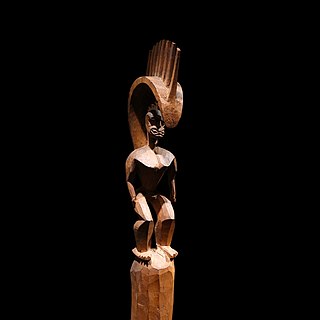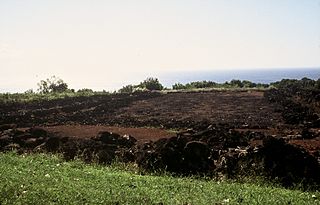In the traditions of ancient Hawaiʻi, Kanaloa is a god symbolized by the squid or by the octopus, and is typically associated with Kāne. It is also an alternative name for the island of Kahoʻolawe.

In Hawaiian religion, the god Lono is associated with fertility, agriculture, rainfall, music and peace. In one of the many Hawaiian stories of Lono, he is a fertility and music god who descended to Earth on a rainbow to marry Laka. In agricultural and planting traditions, Lono was identified with rain and food plants. He was one of the four gods who existed before the world was created. Lono was also the god of peace. In his honor, the great annual festival of the Makahiki was held. During this period, war and unnecessary work was kapu (forbidden).
In Hawaiian mythology, Nāmaka appears as a sea goddess in the Pele family. She is an older sister of Pele-honua-mea.

Waimea is a census-designated place (CDP) in Kauaʻi County, Hawaiʻi, United States. The population was 2,057 at the 2020 census. The first Europeans to reach Hawaii landed in Waimea in 1778.

In Hawaiian religion, Pele is the goddess of volcanoes and fire and the creator of the Hawaiian Islands. Often referred to as "Madame Pele" or "Tūtū Pele" as a sign of respect, she is a well-known deity within Hawaiian mythology and is notable for her contemporary presence and cultural influence as an enduring figure from ancient Hawaii. Epithets of the goddess include Pele-honua-mea and Ka wahine ʻai honua.

Kawainui Marsh or Kawainui Fishpond is a wetland and former fishpond in Kailua, Hawaiʻi. It is the largest remaining wetland and the largest ancient freshwater fishpond in Hawaiʻi, and a designated Ramsar Convention wetland.

Ancient Hawaiʻi is the period of Hawaiian history preceding the unification in 1810 of the Kingdom of Hawaiʻi by Kamehameha the Great. Traditionally, researchers estimated the first settlement of the Hawaiian islands as having occurred sporadically between 400 and 1100 CE by Polynesian long-distance navigators from the Samoan, Marquesas, and Tahiti islands within what is now French Polynesia. In 2010, a study was published based on radiocarbon dating of more reliable samples which suggests that the islands were settled much later, within a short timeframe, in about 1219 to 1266.
The following is an alphabetical list of articles related to the U.S. state of Hawaii:

The House of Kawānanakoa, or the Kawānanakoa Dynasty, are descendants to the throne of the Kingdom of Hawaiʻi.
Paʻao is a figure from Hawaii. He is most likely a Hawaiian historical character retold through Hawaiian legend. According to Hawaiian tradition and folklore, he is said to have been a high priest from Kahiki, specifically "Wewaʻu" and "ʻUpolu." In Hawaiian prose and chant, the term "Kahiki" is applied in reference to any land outside of Hawaii, the linguistic root is conclusively derived from Tahiti. "Wewaʻu" and "Upolu" point to actual places in, Tahiti, and Hawaiian scholars and royal commentators consistently claim Paʻao came from Tahiti.

A heiau is a Hawaiian temple. Made in different architectural styles depending upon their purpose and location, they range from simple earth terraces, to elaborately constructed stone platforms. There are heiau to treat the sick, offer first fruits, offer first catch, start rain, stop rain, increase the population, ensure the health of the nation, achieve success in distant voyaging, reach peace, and achieve success in war (luakini).
In Hawaiian mythology, the Nawao are a legendary people, a wild, large-sized hunting people, descended from Lua-nu'u. Other sources suggest that the Nawao were present in Hawaii before the Menehune who are thought to have driven them out or destroyed them. However, folklorist Katherine Luomala believes that the legends of the Menehune and similar creatures are a post-European contact mythology.

Puʻu o Mahuka Heiau State Historic Site on the North Shore of Oʻahu is the largest heiau (temple) on the island, covering 2 acres (8,100 m2) on a hilltop overlooking Waimea Bay and Waimea Valley. From its commanding heights, sentries could once monitor much of the northern shoreline of Oʻahu, and even spot signal fires from the Wailua Complex of Heiaus on Kauaʻi, with which it had ties. It was designated a National Historic Landmark in 1962, when it became the center of a 4-acre (16,000 m2) state park. It was added to the National Register of Historic Places in 1966.

Honopū Valley is a landmark valley within Nā Pali Coast State Park along the northwest shore of Kauaʻi, Hawaiʻi, United States. It is known for its distinctive natural arch, which at approximately 90 feet (27 m) tall is the tallest in Hawaii. At the lower end of the valley is Honopū's secluded, 0.25-mile (0.40 km) beach, also known as Cathedral Beach.
In Hawaiian mythology, Kaupe is a malevolent spirit that calls out to people at night to lure them to their deaths. According to legend, he used to rule Nu'uanu Valley.

Kamakahelei, was alii nui, or Queen regnant, of the island of Kauaʻi. She was the ruling chiefess of Kauaʻi reigning from 1770 - 1794. In some historical references she has been described as a regent for her sons Keawe and Kaumualii. She was the sovereign of the Island of Kauai at the time Captain James Cook landed on its shores. The Chiefess Kamakahelei Middle School in the district of Puhi is named after her. This school serves the Kalaheo to Hanamaulu districts on the island of Kauai.

The island of Maui with a relatively central location has given it a pivotal role in the history of the Hawaiian Islands.
Deborah Kapule Kekaihaʻakūlou was the last Queen of Kauaʻi before the establishment of the Kingdom of Hawaiʻi by King Kamehameha I.

The Menehune Fishpond, near Līhuʻe, Hawai`i, on the island of Kaua`i, is a historic Hawaiian fishpond. Also known as Alakoko Fishpond, it has been listed on the U.S. National Register of Historic Places.
In Hawaiian mythology, Hauwahine was a moʻo and the guardian spirit of Kawainui Fishpond as well as Pā'eo and Kaʻelepulu fishponds.














